If you’re an avid climber or someone looking to get into the thrilling sport of climbing, choosing the right climbing harness is of utmost importance. A climbing harness is an essential piece of equipment that ensures your safety and comfort while scaling vertical heights. In this comprehensive guide, we will walk you through everything you need to know about choosing the perfect climbing harness. From understanding the different types of harnesses to considering the specific features, fit, and safety considerations, we’ve got you covered. So, let’s dive in and equip you with the knowledge to make an informed decision.
Table of Contents
Parts of a Climbing Harness
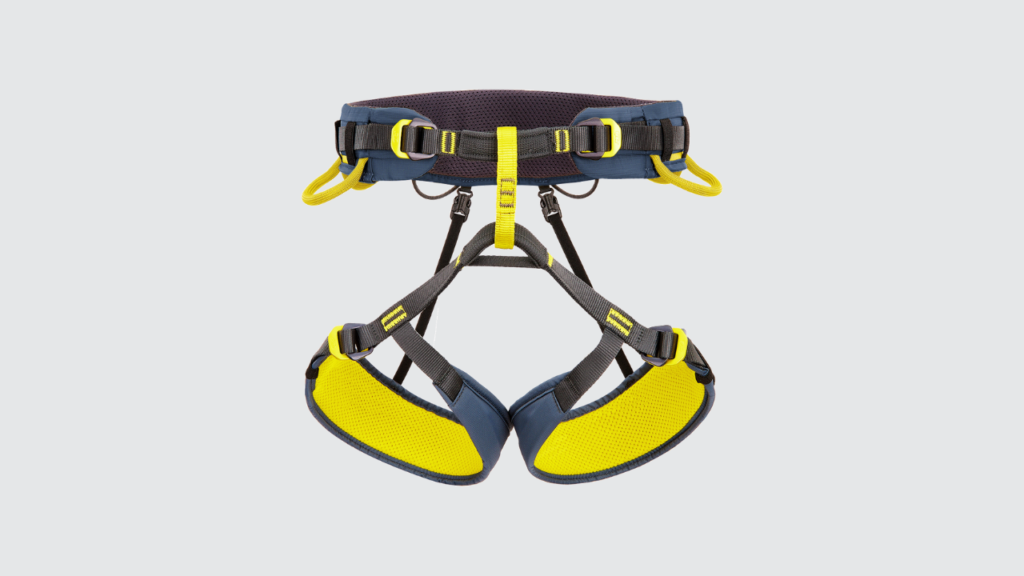 To gain a comprehensive understanding of climbing harnesses, it is essential to explore their anatomy. A typical climbing harness is composed of various components, each serving a specific function in providing safety, comfort, and functionality. Let’s take a closer look at the different parts of a climbing harness:
To gain a comprehensive understanding of climbing harnesses, it is essential to explore their anatomy. A typical climbing harness is composed of various components, each serving a specific function in providing safety, comfort, and functionality. Let’s take a closer look at the different parts of a climbing harness:
Waist Belt
The waist belt is the primary component of the harness that encircles the waist of the climber. It is responsible for supporting the climber’s weight and distributing it evenly across the body. The waist belt is usually padded to enhance comfort during long climbs and to prevent pressure points.
Waist Buckle
The waist buckle is an adjustable mechanism located on the waist belt. It allows climbers to secure the harness firmly around their waist. The buckle can be tightened or loosened to achieve a customized and secure fit.
Leg Loops
The leg loops are loops that encircle the legs and connect to the waist belt. They provide stability and prevent the harness from riding up during climbs. Leg loops are adjustable to accommodate different leg sizes and can be tightened or loosened for a comfortable and secure fit.
The Rise
The rise refers to the distance between the waist belt and the leg loops. It plays a crucial role in determining the comfort and fit of the harness. A proper rise ensures that the harness stays in place and does not create discomfort or restrict movement while climbing.
Tie-in Loops
Tie-in loops are reinforced loops located on the waist belt of the harness. They serve as attachment points for the climbing rope. Climbers tie into these loops using appropriate knots to secure themselves to the harness and ensure a reliable connection between the climber and the rope.
Belay Loop
The belay loop is a load-bearing loop positioned at the front of the harness. It serves as the connection point for the belay device, which is used to manage the rope during climbing and belaying. The belay loop is designed to withstand significant forces and provides a secure anchor point for belaying.
Haul Loop
The haul loop is an additional loop located at the back of the harness. It is primarily used for attaching equipment such as haul bags, extra gear, or backpacks. The haul loop allows climbers to carry essential items without interfering with their movement or access to other gear loops.
Gear Loops
Gear loops are loops located on the sides of the harness. They are designed to hold and organize climbing equipment, such as carabiners, quickdraws, cams, or other essential gear. The number and size of gear loops may vary depending on the type and intended use of the harness.
Types of Climbing Harnesses
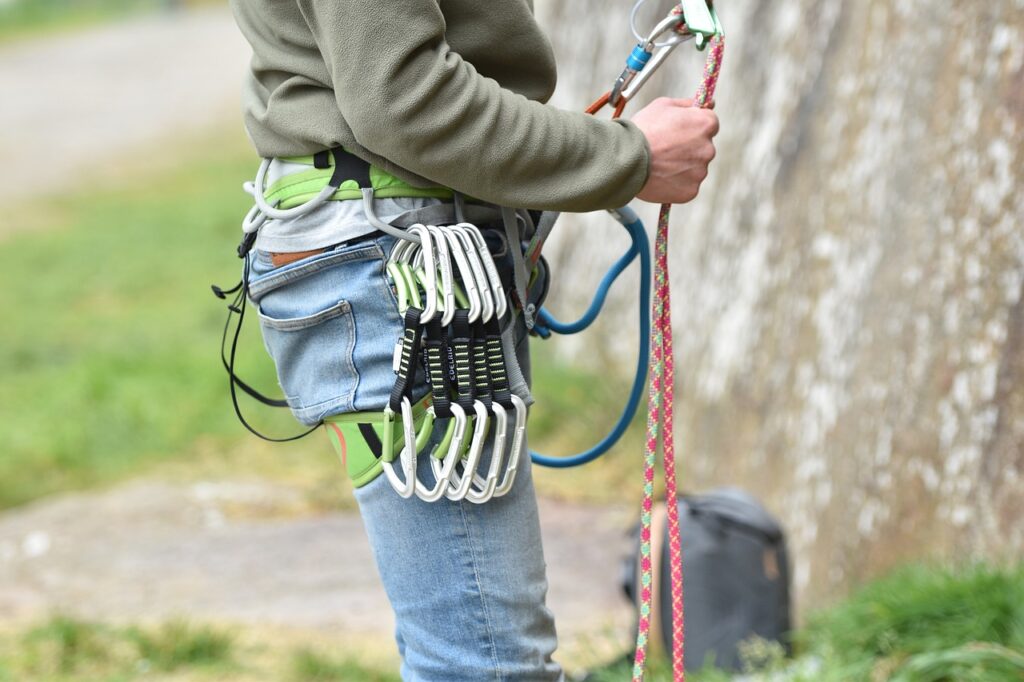
Climbing harnesses are available in a variety of types, each specifically designed to meet the unique demands of different climbing disciplines. Understanding these types is crucial in selecting the right harness for your climbing adventures. Let’s explore the most common types of climbing harnesses:
Gym and Sport Climbing Harnesses
Gym climbing and sport climbing are popular indoor and outdoor activities that require a specific type of harness. These harnesses are designed with lightweight materials and a minimalist approach, prioritizing freedom of movement and breathability. They typically feature fewer gear loops since the focus is on quick and efficient climbing. Look for a gym or sport climbing harness that offers comfort, durability, and the ability to handle frequent use.
Trad and Multi-Pitch Climbing Harnesses
Traditional (trad) climbing and multi-pitch climbing involve placing gear as you ascend, making the harness requirements slightly different. Trad and multi-pitch climbing harnesses are designed to carry a larger number of climbing accessories, including nuts, cams, and slings. They have multiple gear loops strategically placed for easy access to gear while climbing. Comfort and support are crucial, as these types of climbs often require spending extended periods hanging or belaying. Look for a trad or multi-pitch climbing harness that offers ample padding, adjustability, and gear-carrying capacity.
Alpine Climbing and Mountaineering Harnesses
For those seeking high-altitude adventures and extreme conditions, alpine climbing and mountaineering harnesses are the go-to choice. These harnesses offer versatility, adjustability, and the ability to handle harsh environments. Alpine climbing harnesses prioritize lightweight construction, as climbers need to carry their gear while navigating glaciers, snow, and ice. Look for an alpine climbing harness that provides insulation, a comfortable fit with adjustable leg loops and waist belts, and sufficient gear loops for carrying ice screws and other equipment.
Ice Climbing Harnesses
Ice climbing presents unique challenges that require specialized equipment, including ice climbing harnesses. These harnesses are designed with insulation to provide protection against cold temperatures. They feature additional gear loops for carrying ice screws, ice tools, and other necessary gear. Ice climbing harnesses also have reinforced tie-in points to withstand the forces exerted while ascending frozen waterfalls and ice formations. Look for an ice climbing harness that offers warmth, durability, and enhanced safety features specifically designed for ice climbing.
The Difference Between Men’s and Women’s Harnesses
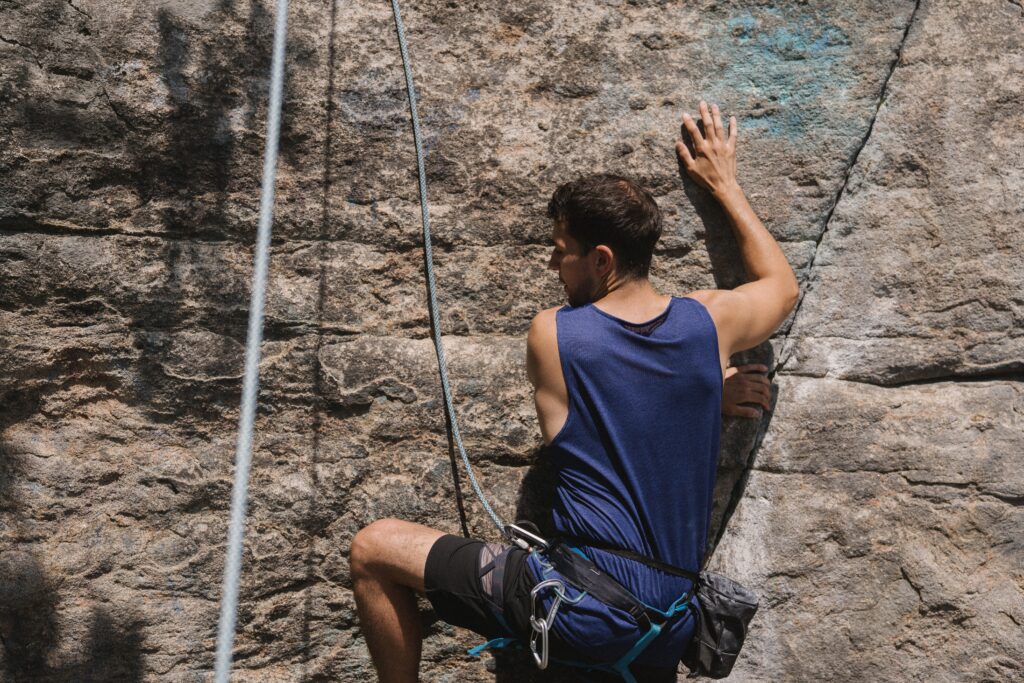 Climbing harnesses are not one-size-fits-all, as they are designed to accommodate the differences in body shapes and sizes between men and women. Recognizing the unique anatomical requirements of each gender, harness manufacturers have developed specific designs for men, women, and children. Here’s an overview of the key differences between men’s and women’s climbing harnesses:
Climbing harnesses are not one-size-fits-all, as they are designed to accommodate the differences in body shapes and sizes between men and women. Recognizing the unique anatomical requirements of each gender, harness manufacturers have developed specific designs for men, women, and children. Here’s an overview of the key differences between men’s and women’s climbing harnesses:
Men’s Climbing Harness
Men’s harnesses are tailored to the male anatomy, taking into consideration the broader waist and hips typically found in men. They often feature a straighter waist belt and a longer rise. The straight waist belt is designed to provide a comfortable fit around the waist, while the longer rise ensures optimal positioning of the leg loops. These features allow men to climb with freedom of movement and ensure a secure and supportive fit.
Women’s Climbing Harnesses
Women’s harnesses are specifically designed to accommodate the unique proportions of the female body. They feature a contoured waist belt that takes into account the natural curves of a woman’s waist and hips. The contoured shape enhances the comfort and fit of the harness, reducing pressure points and ensuring a secure feel during climbs. Women’s harnesses also have a shorter rise, accommodating the shorter distance between the waist and leg loops. This design prevents the harness from shifting and provides a better fit around the hips. Additionally, the leg loops in women’s harnesses are positioned slightly differently to accommodate the hip structure of women.
Kids Climbing Harnesses
Children’s harnesses are designed to cater to the growing bodies of young climbers. They typically feature adjustable leg loops and waist belts, allowing for flexibility as the child grows. These adjustable components ensure a safe and comfortable fit for young climbers, providing the necessary support while adapting to their changing body sizes.
Features of a Climbing Harness
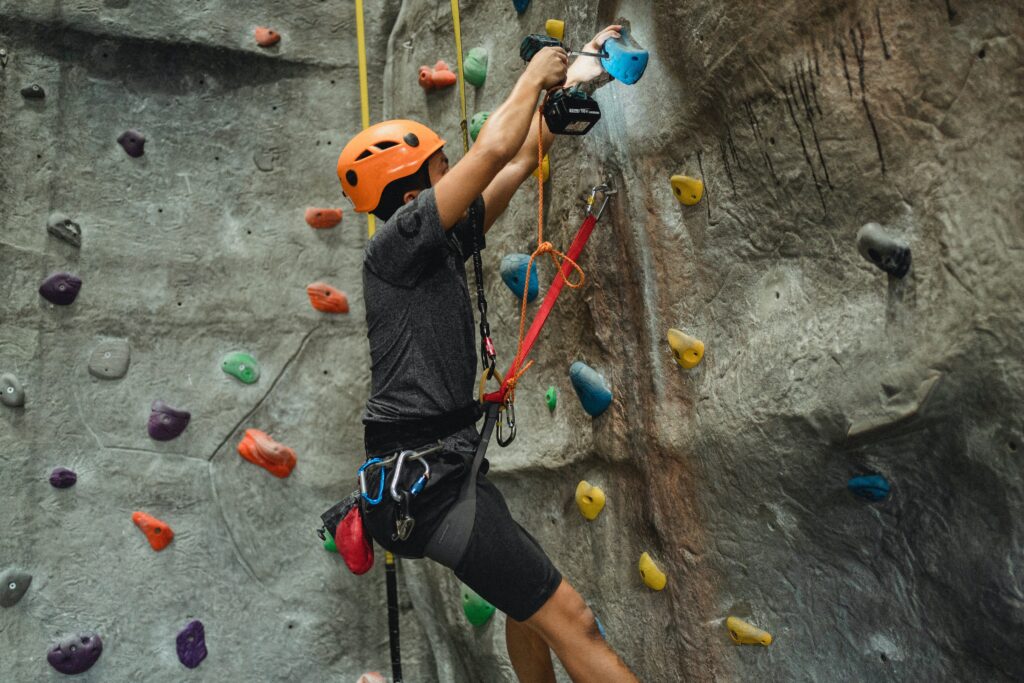 When selecting a climbing harness, it’s essential to consider the following features that will cater to your climbing preferences and requirements:
When selecting a climbing harness, it’s essential to consider the following features that will cater to your climbing preferences and requirements:
Padding
One of the key features to look for in a climbing harness is extra padding on the waist belt and leg loops. This additional padding provides enhanced comfort during long climbs by reducing pressure points and minimizing discomfort caused by hanging or prolonged suspension. The padding also helps distribute the load more evenly, allowing you to climb with greater ease and endurance.
Adjustability
Climbing harnesses should have multiple adjustment points to ensure a customized and secure fit. These adjustment options allow you to fine-tune the harness to your body shape and size, providing optimal comfort and safety. Look for harnesses with adjustable waist belts and leg loops that can be easily tightened or loosened to accommodate different clothing layers or varying body sizes.
Gear Loops
Consider the number and placement of gear loops on the climbing harness. Gear loops are essential for carrying climbing accessories such as carabiners, quickdraws, cams, and other essential equipment. Ensure that the harness has sufficient gear loops to accommodate the number of climbing accessories you typically carry. Multiple gear loops allow for better organization and accessibility, so you can have your gear within reach when you need it most.
Haul Loop
A haul loop is an additional loop located at the back of the harness, typically used for attaching gear or carrying ropes. This loop comes in handy when you need to haul extra equipment or when you’re climbing multi-pitch routes that require carrying additional gear. Look for a harness with a sturdy and well-placed haul loop that can handle the weight of your gear and provide convenience during climbs that require hauling.
Weight
The weight of a climbing harness can significantly impact your climbing experience. Consider the weight of the harness based on your climbing style and preferences. If you prioritize mobility and freedom of movement, opt for a lightweight harness that won’t hinder your agility on the wall. On the other hand, if you value additional support and durability, a more substantial harness may be suitable for you. Finding the right balance between weight and support is crucial for a comfortable and efficient climbing experience.
Safety Rating
When it comes to safety, always look for a climbing harness that has been certified by relevant safety organizations such as the UIAA (International Climbing and Mountaineering Federation) or CE (Conformité Européene). These certifications ensure that the harness meets rigorous safety standards and has undergone thorough testing for strength, durability, and performance. Choosing a certified harness gives you peace of mind, knowing that your safety is a top priority.
Fitting a Climbing Harness
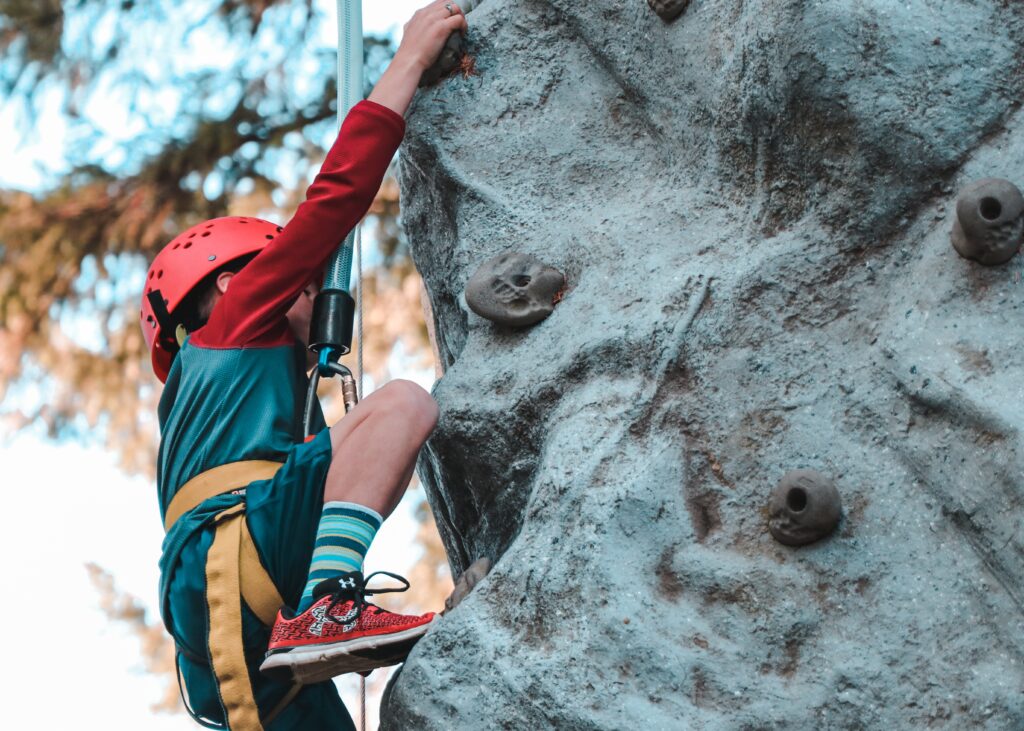 Properly fitting a climbing harness is vital to ensure both comfort and safety during your climbing adventures. A well-fitted harness will provide security and freedom of movement while minimizing the risk of injury. Follow these steps to achieve a secure and comfortable fit for your climbing harness:
Properly fitting a climbing harness is vital to ensure both comfort and safety during your climbing adventures. A well-fitted harness will provide security and freedom of movement while minimizing the risk of injury. Follow these steps to achieve a secure and comfortable fit for your climbing harness:
- Loosen all the straps: Before putting on the harness, make sure all the straps are loosened. This step allows for easy entry into the harness and prevents any potential discomfort caused by tight straps.
- Step into the leg loops: Place your feet through the leg loops and pull the harness up to your waist. Ensure that the leg loops are not twisted and are properly aligned with your legs.
- Adjust the waist belt: Securely fasten the waist belt around your waist, ensuring it sits comfortably above your hips. The waist belt should fit snugly, providing support without being overly tight. It should be positioned evenly around your waist, with no excess slack or tightness.
- Tighten the leg loops: Adjust the leg loops to achieve a snug fit around your thighs. The leg loops should be tight enough to prevent the harness from riding up during climbing but not excessively tight to restrict blood flow or cause discomfort. Ensure that the leg loops are evenly tightened and provide a secure fit.
- Double-check all fastenings: Once you have adjusted the waist belt and leg loops, double-check that all buckles and straps are securely fastened. Give each buckle a gentle tug to ensure it is properly engaged and will not come undone during your climb.
- Perform a “finger check”: To determine if the waist belt is appropriately snug, perform a finger check. Try to insert two fingers between your waist and the waist belt. If you can comfortably fit two fingers, the harness is correctly adjusted. If it is too loose and you can fit more than two fingers, tighten the waist belt accordingly. Conversely, if you cannot fit two fingers, it indicates that the waist belt is too tight, and you should loosen it slightly for a better fit.
Steps for Testing a Harness
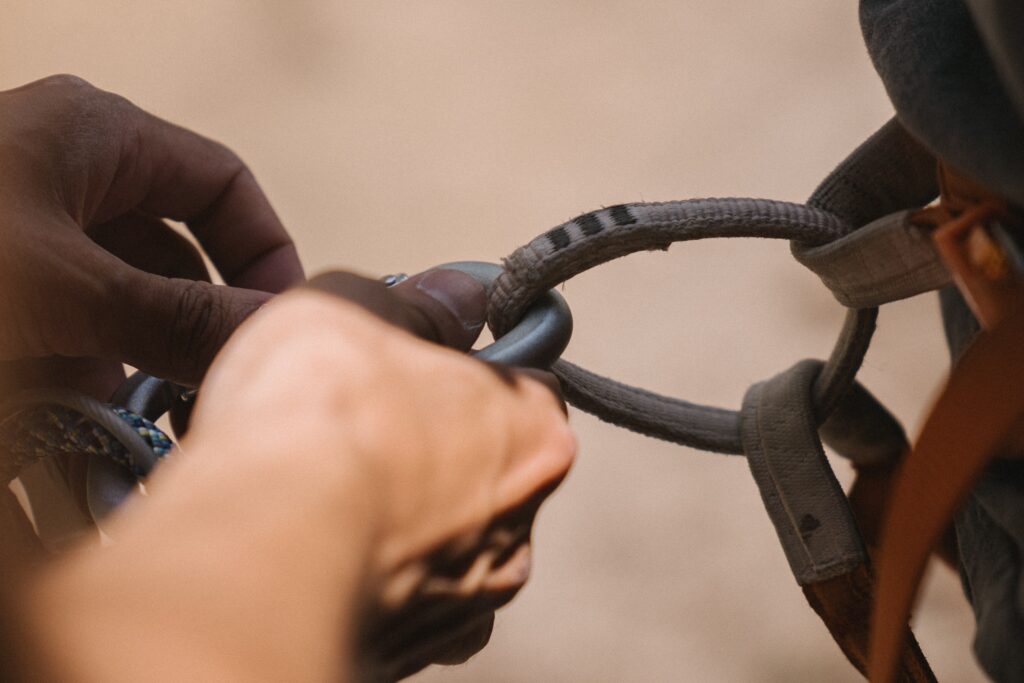 Before entrusting your safety to a climbing harness, it is crucial to perform a thorough test to ensure its integrity and reliability. By following these steps, you can assess the harness’s condition and confirm its ability to support your weight effectively:
Before entrusting your safety to a climbing harness, it is crucial to perform a thorough test to ensure its integrity and reliability. By following these steps, you can assess the harness’s condition and confirm its ability to support your weight effectively:
- Carefully inspect the harness: Begin by visually examining the entire harness for any signs of wear, damage, or fraying. Pay close attention to the webbing, stitching, buckles, and attachment points. If you notice any significant wear, tears, or signs of deterioration, it is advisable to replace the harness to maintain your safety.
- Check buckles, straps, and stitching: Ensure that all buckles are functioning correctly and can be securely fastened and released. Check the straps for any signs of weakness or fraying. Inspect the stitching to ensure it is intact and shows no signs of unraveling. These checks help ensure that all components of the harness are in good working order.
- Attach the harness securely: Find a sturdy anchor point or object designed for testing harnesses. This can be a sturdy tree branch, an anchor point at a climbing gym, or any other suitable attachment point. Make sure it can hold your weight and provide a stable base for testing.
- Apply body weight gradually: Step into the harness and gradually apply your body weight to it. Ensure that the harness distributes your weight evenly and that all the straps and buckles remain secure. Take a moment to assess how the harness feels under tension, ensuring there are no unexpected shifts or discomfort.
- Perform a “bounce test”: To test the harness’s shock-absorbing properties, perform a gentle bounce or jump while securely attached. This action simulates a sudden impact or fall and allows you to evaluate how the harness handles the force. Observe if the harness provides a comfortable and controlled descent without any excessive jarring or discomfort.
How to Size a Climbing Harness
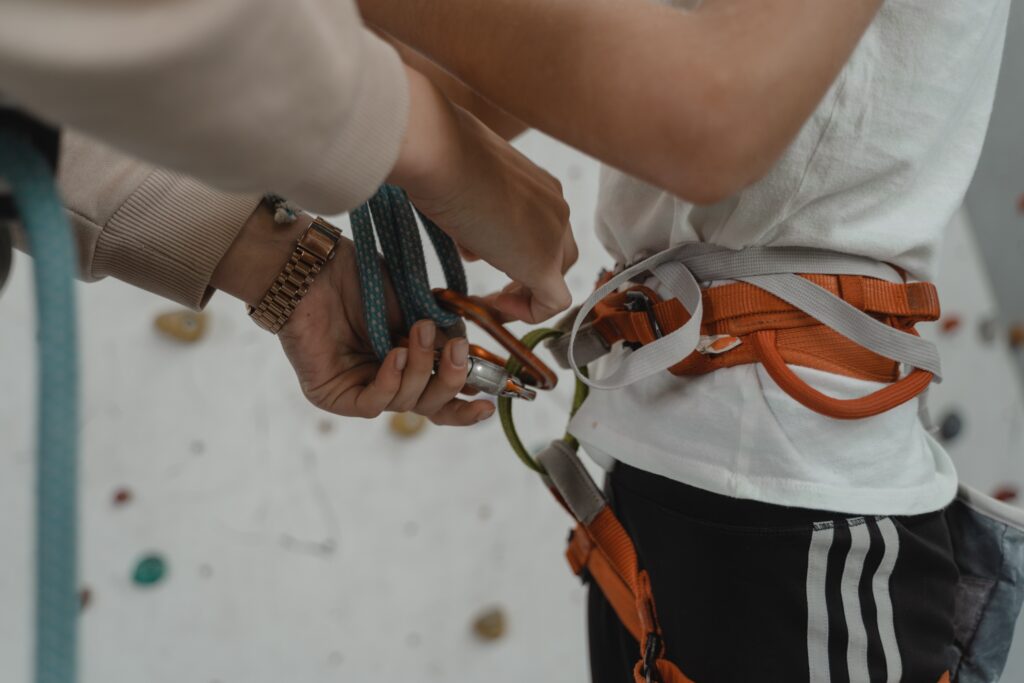 Properly sizing a climbing harness is essential for achieving optimal comfort and safety during your climbing adventures. Here’s a step-by-step guide to help you determine the right size:
Properly sizing a climbing harness is essential for achieving optimal comfort and safety during your climbing adventures. Here’s a step-by-step guide to help you determine the right size:
- Measure your waist circumference: Using a flexible measuring tape, measure your waist circumference at the narrowest point above your hips. Make sure the tape is snug but not too tight. This measurement will serve as a starting point for finding the right harness size.
- Consult the manufacturer’s size chart: Refer to the size chart provided by the harness manufacturer. Different brands may have slightly different sizing standards, so it’s crucial to rely on the specific chart for the harness you’re considering. Match your waist measurement with the corresponding size range provided on the chart.
- Try on different harness sizes: It’s important to physically try on harnesses of different sizes to find the best fit. Visit a reputable climbing gear store or rental facility where you can access a variety of harnesses. Follow the manufacturer’s instructions for adjusting the harness to ensure an accurate fit.
- Ensure a snug and comfortable fit: When trying on a harness, make sure it fits snugly around your waist without being overly tight or causing any discomfort. The waist belt should sit above your hips and distribute the load evenly. The leg loops should be adjustable to achieve a secure fit without restricting movement or causing pinching.
Steps for Putting on a Climbing Harness
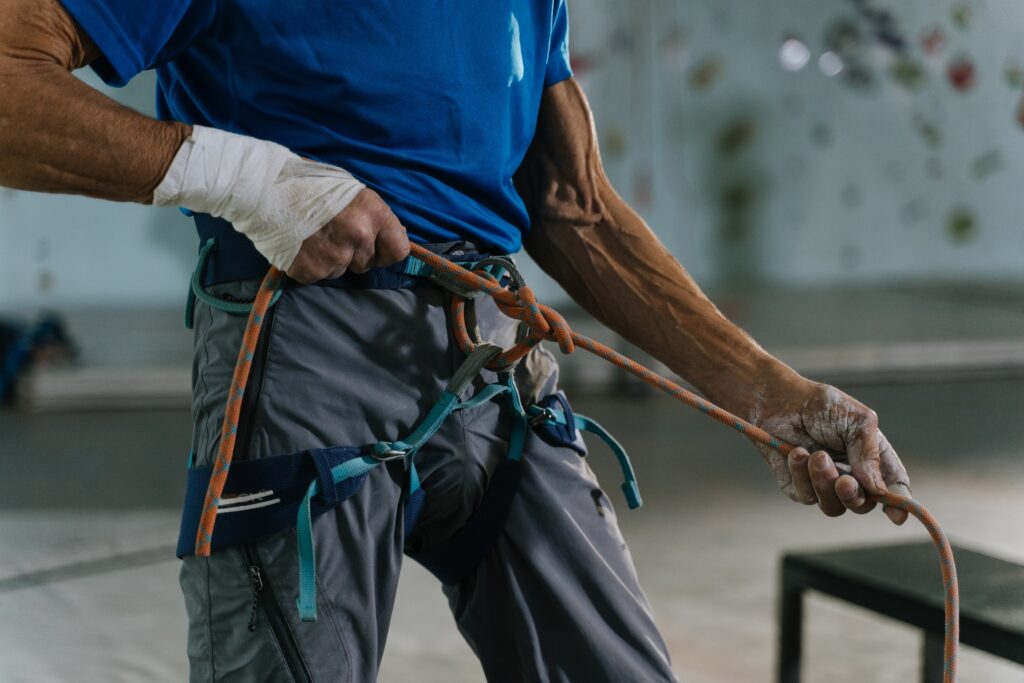 Putting on a climbing harness correctly is essential for your safety and comfort during your climbing adventures. Follow these step-by-step instructions to ensure a proper fit:
Putting on a climbing harness correctly is essential for your safety and comfort during your climbing adventures. Follow these step-by-step instructions to ensure a proper fit:
- Loosen all the straps before stepping into the harness: Before you put on the harness, make sure all the straps are loosened. This allows for easier maneuvering and prevents any unnecessary tension when putting it on.
- Step into the leg loops and pull the harness up to your waist: Place your feet through the leg loops one at a time, ensuring they are properly aligned. Gradually pull the harness up towards your waist while holding onto the waist belt.
- Fasten the waist buckle and tighten it snugly: Once the harness is around your waist, locate the waist buckle. Insert the buckle tongue into the corresponding buckle slot and adjust the buckle to a snug fit. Be careful not to overtighten, as it may restrict your movement and cause discomfort.
- Adjust the leg loops, ensuring they are secure but not overly tight: Check the fit of the leg loops. They should fit comfortably around your thighs without cutting into your skin or restricting blood flow. Adjust the leg loops by tightening or loosening the corresponding straps until they are snug but not overly tight.
- Double-check all the buckles and straps to ensure they are properly fastened: Take a moment to inspect all the buckles, straps, and attachments on the harness. Ensure that each buckle is securely fastened and that all straps are properly aligned and tightened. This step is crucial for your safety and to prevent any accidents while climbing.
Sport Climbing Harnesses
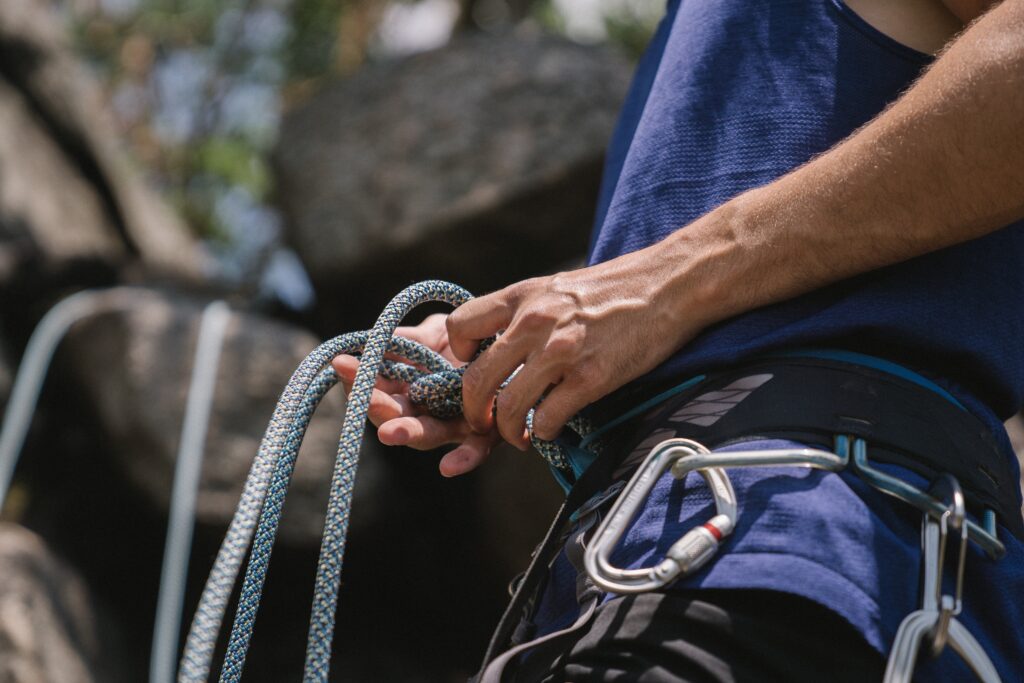
Sport climbing harnesses are specifically designed to meet the unique demands of sport climbing, which involves climbing on pre-placed bolts and fixed anchors. These harnesses prioritize certain features that enhance performance and comfort during sports climbing sessions. Let’s explore the key aspects of sport climbing harnesses:
Lightweight Construction
One of the primary considerations when choosing a sport climbing harness is its weight. Since sport climbers often focus on climbing quickly and efficiently, a lightweight harness can make a noticeable difference. Look for harnesses that utilize lightweight materials and innovative designs without compromising on safety or durability.
Breathability
Sport climbing requires significant physical exertion, which can lead to sweating and discomfort. To address this, sports climbing harnesses often incorporate breathable materials and designs that allow air circulation and ventilation. This feature helps to keep climbers cool and dry during intense climbing sessions.
Freedom of Movement
In sport climbing, climbers need maximum freedom of movement to execute dynamic moves and perform intricate sequences. Sport climbing harnesses are designed with this in mind, featuring a streamlined profile and minimal bulk. They offer a snug, contoured fit that allows for unrestricted movement of the hips, legs, and upper body.
Ample Padding
Although sport climbing harnesses prioritize lightweight construction, they still provide sufficient padding for comfort and protection. Look for harnesses that have strategic padding in the waist belt and leg loops, which help to distribute the pressure evenly and reduce discomfort during prolonged climbs. The padding should be substantial enough to provide support without adding unnecessary weight or bulk.
Gear Loops
Sport climbers often carry a range of gear, including quickdraws, carabiners, and other climbing equipment. To accommodate these essentials, sport climbing harnesses typically feature multiple gear loops. These loops are conveniently positioned on the sides or back of the harness, allowing climbers to organize and access their gear easily. Consider the number and size of gear loops based on your specific needs.
Comfortable Fit for Extended Climbing
Sport climbing sessions can last for extended periods, requiring a harness that remains comfortable throughout. Look for a harness with adjustable straps and buckles that allow for a personalized fit. Additionally, harnesses with features like leg risers and waist belt buckle that stay securely fastened help maintain comfort and stability even during prolonged climbs.
Safety Features
While sport climbing harnesses focus on performance and comfort, safety should always remain a top priority. Ensure that the harness you choose complies with relevant safety standards, such as those set by the UIAA (International Climbing and Mountaineering Federation) or CE (Conformité Européene). These certifications ensure that the harness has undergone rigorous testing and meets stringent safety requirements.
Harness Wear and Retirement
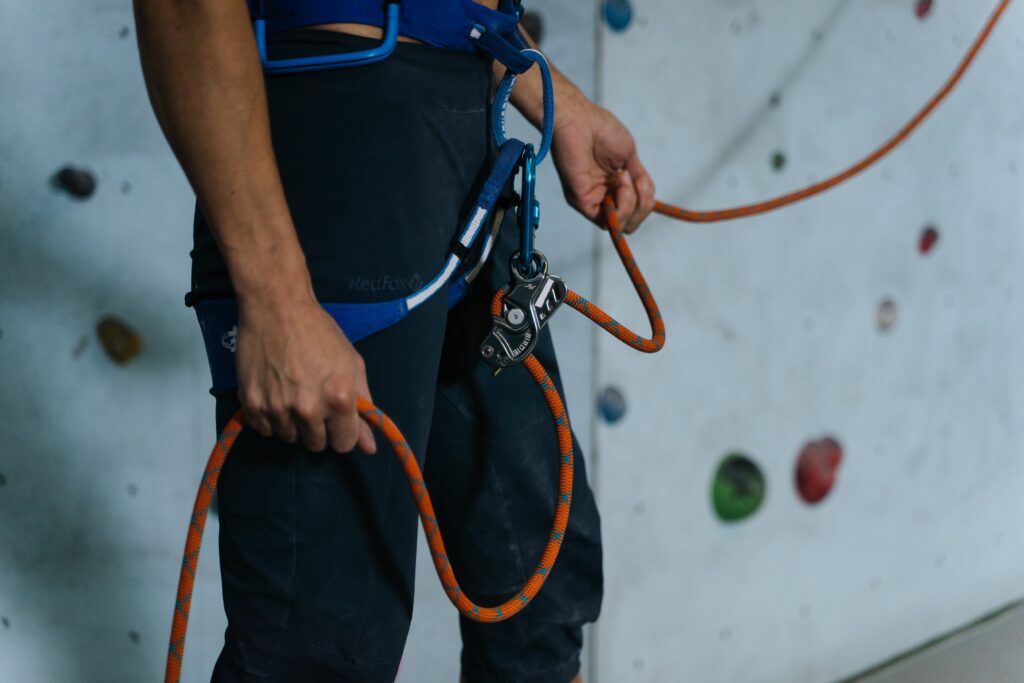 Knowing when to retire a climbing harness is crucial for your safety. Over time, harnesses can experience wear and tear that compromises their structural integrity. Here are some essential points to consider regarding harness wear and retirement:
Knowing when to retire a climbing harness is crucial for your safety. Over time, harnesses can experience wear and tear that compromises their structural integrity. Here are some essential points to consider regarding harness wear and retirement:
Signs of Wear and Damage
Regularly inspect your harness for the following signs of wear and damage:
- Frayed or Worn Webbing: Check the waist belt, leg loops, and all webbing components for fraying, thinning, or significant wear.
- Stitching Integrity: Examine the stitching throughout the harness for any signs of loose or broken threads.
- Buckle Functionality: Ensure that all buckles, including the waist buckle and leg loop buckles, are functioning properly and show no signs of damage.
- Hardware Integrity: Inspect any metal components, such as gear loops and belay loops, for corrosion, cracking, or significant wear.
- Elasticity of Leg Loops: If your harness has elastic leg loops, check their elasticity and ensure they are still providing a snug fit.
Retirement Guidelines
While harness lifespan can vary based on usage, environmental factors, and manufacturer recommendations, it’s generally advised to retire a climbing harness under the following circumstances:
- Visible Damage: If you notice any significant wear, damage, or compromised integrity in the harness’s webbing, stitching, or hardware, it is time to retire the harness immediately.
- Age and Frequency of Use: Even if a harness shows no visible signs of damage, it is recommended to retire it after five years of regular use or as specified by the manufacturer.
- Safety Recalls: Stay informed about safety recalls issued by manufacturers. If your harness is affected by a recall, follow the manufacturer’s instructions for replacement or retirement.
Proper Disposal
When retiring a climbing harness, it’s important to dispose of it properly. Here are a few options for responsible harness disposal:
- Recycling Programs: Some climbing gear manufacturers offer recycling programs specifically for retired harnesses. Check with the manufacturer or your local climbing retailer to see if they have any recycling initiatives in place.
- Creative Repurposing: Consider repurposing your old harness for non-climbing uses. It can be used as a tool belt, dog leash, or for other creative purposes, as long as it does not compromise safety.
- Cut and Discard: If you’re unable to recycle or repurpose the harness, cut it into several pieces to render it unusable, then dispose of it with your regular waste. This prevents anyone from attempting to use a retired harness unknowingly.
Care & Maintenance
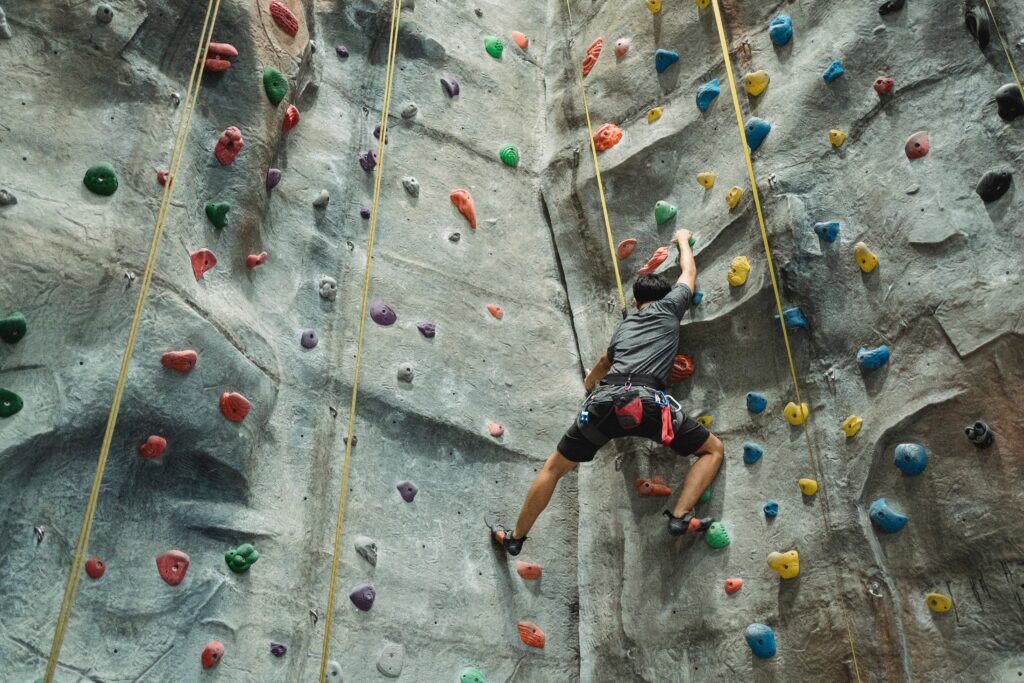 Proper care and maintenance of your climbing harness are essential to extend its lifespan and ensure its performance and safety. Here are some key guidelines to follow:
Proper care and maintenance of your climbing harness are essential to extend its lifespan and ensure its performance and safety. Here are some key guidelines to follow:
Cleaning
Regularly clean your climbing harness to remove dirt, sweat, and other contaminants. Follow these steps:
- Fill a basin or sink with lukewarm water and a mild detergent specifically formulated for technical gear.
- Immerse the harness in soapy water and gently agitate it.
- Use a soft brush or cloth to scrub any particularly dirty areas, paying attention to the waist belt, leg loops, and gear loops.
- Rinse the harness thoroughly with clean water to remove any soap residue.
- Pat the harness dry with a clean towel or allow it to air dry away from direct sunlight.
Storage
Proper storage helps maintain the condition of your climbing harness. Follow these storage guidelines:
- Dryness: Always store your harness in a cool, dry place. Avoid exposing it to excessive heat or moisture, as these can degrade the materials.
- Avoid Weight: Do not hang heavy objects on the harness, as this can distort its shape and compromise its structural integrity.
- Protection: Consider storing the harness in a dedicated gear bag or pouch to protect it from dust, dirt, and potential damage from other gear.
Inspections
Regular inspections ensure that your harness remains in good working condition. Perform the following checks before each use:
- Webbing and Stitching: Check for any signs of fraying, thinning, or significant wear on the webbing and inspect the stitching for integrity.
- Buckles and Hardware: Verify that all buckles and hardware are functioning properly, without any signs of damage or corrosion.
- Elastic Components: If your harness has elastic leg loops, ensure they are still providing a snug fit and haven’t lost their elasticity.
- Safety Labels and Markings: Check that all safety labels and markings are intact and legible. These provide essential information about the harness and its certifications.
Professional Inspection
Consider having your climbing harness professionally inspected on a periodic basis. Some climbing retailers or gear repair services offer this service to ensure your harness is in optimal condition.
FAQs
- Q: How often should I replace my climbing harness?
- A: It is recommended to replace your climbing harness every 5 years, or sooner if you notice any signs of wear or damage.
- Q: Can I use a climbing harness for other activities like mountaineering or via Ferrata?
- A: Yes, certain climbing harnesses are versatile enough to be used for other activities such as mountaineering or via Ferrata. However, it’s essential to ensure the harness is suitable and meets the specific safety requirements of the activity.
- Q: Can I borrow or rent a climbing harness?
- A: While it is possible to borrow or rent a climbing harness, it is generally recommended to use your own harness to ensure the correct fit and familiarity with the equipment.
- Q: Are there specific harnesses designed for individuals with larger body sizes?
- A: Yes, some manufacturers offer climbing harnesses specifically designed for individuals with larger body sizes. These harnesses typically have extended waist belts and larger leg loop sizes to accommodate a broader range of climbers.
- Q: Can I use a climbing harness for rock climbing and mountaineering?
- A: Yes, many climbing harnesses are suitable for both rock climbing and mountaineering. However, it’s essential to consider the specific requirements of your chosen activity and choose a harness that meets those needs.








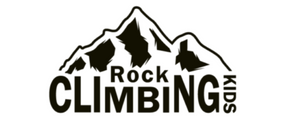
Discussion about this post